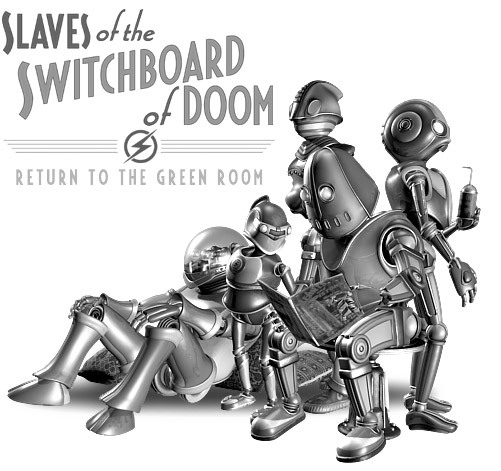

Here’s an updated shot from the Illustration Green Room, where a growing mob of robot characters are more or less patiently waiting for their appearances. We’re running out of magazines in there.
For those who came in late: after several self-published books, I’ve been experimenting with that whole (very) long process that we’ve come to know as "traditional publishing".
That process usually starts with a writer contacting a bunch of literary agents (in this case, twenty-one). That was my Phase One. Apart from a terrific response from my first choice, the results of my agent search went pretty much the way they go for everybody else. I do have one unusual hold-out who’s still planning to read the book even though he’s encouraged me to embark on Stage Two.
In Stage Two, instead of risking humiliation and despair at the hands of literary agents I go directly to the source of humiliation and despair: editors!
Even those writers who pass the trials of what I’ve called Phase One still have a Phase Two to face; in their case it’s the agent who submits to editors. Those of us who still don’t have agents end up in a slush pile of manuscripts that, for editors, is kind of like the Augean stables. Possibly in more ways than one. But – importantly – a slush pile resembles the Augean stables because it can never be exhausted. It just keeps piling up.
You really don’t want your book in slush pile: there’s no way of knowing when it may come out. But I begin Phase One with a leg up, since an editor who noticed my posts about the book has asked to see it. So, for the moment, no slush pile for me. Just another, but completely different, long wait until there may or may not be news. That’s an encapsulated description of traditional publishing, and also of trench warfare.

The agent search ran for a good six months, or… a six months, anyway, and Phase Two has a timetable that’s at least that horrifying. Especially if it turns out that I do have a slush pile in my future. But in the meantime I’m still working on that freelance job I mentioned earlier, and so my work on the illustrations for Slaves of the Switchboard of Doom has been delayed. I’ve been building the robot models I need for some of the remaining pictures, but it would be difficult to work on the illustrations themselves until this side job is behind me. Hence: the state of the Green Room, above.
Send magazines.







I’ve got an annual compilation of Robotics Now from 1982 I can contribute, plus a milk crate full of more recent issues of Servo , Circuit Cellar, and Nuts & Volts magazines.
I hope that this approach works out & turns into real money for you.
One contrast between this and self-publishing is the additional time and labor spent. So far we’re looking at about a 50% increase in (calendar) time. That’s not full time work, of course, but it does represent a lot of additional labor. By the time I’m through with Phase Two the difference may amount to 100%. Possibly more.
The additional time has given me more opportunities for feedback from early readers, and that’s a positive thing. I’ve just finished one more complete editing pass, with many small rewrites, and if I hadn’t had this enforced delay I might not have done as much.
But I’m looking at the additional time as a cost, too, which has to be measured against what the book will earn in the long run–regardless of who publishes it. So, lots of interesting data.